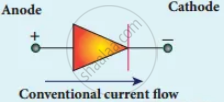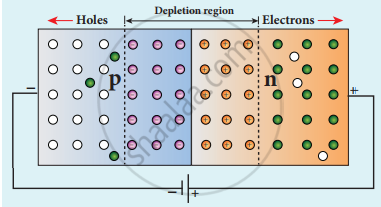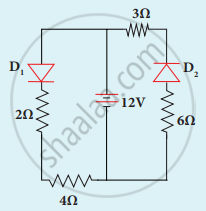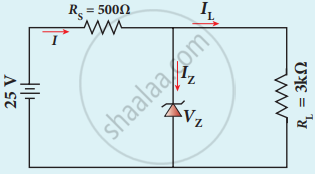Advertisements
Advertisements
प्रश्न
Explain the formation of depletion region and barrier potential in PN junction diode.
उत्तर

Schematic representation

Circuit symbol
1. A p-n junction diode is formed when the p-type semiconductor is fused with an N-type semiconductor.
2. A p-n junction diode is formed when the p-type semiconductor is fused with an N-type semiconductor.
- Forward bias
- Forward bias
a. Forward bias:

- If the positive terminal of the external voltage source is connected to the p-side and the negative terminal to the n-side forward bias takes place.
- Electron moves to n-side holes move to the p side Recombination takes place near the junction and reduces depletion region.
- Electron from n-side accelerates towards p side it experiences reduced potential barrier at the junction.
- Applied voltage is increased, the width of the depletion region and barrier potential further reduced.
- So a large number of electrons pass through the junction.
b. Reverse bias:

- If the positive terminal of the external voltage source is connected to the p-side and the negative terminal to the n-side reverse bias takes place.
- Depletion region is increased potential barrier is also increased.
- Majority of charge carriers from both sides experience a great barrier to cross the junction. So diffusion current reduces.
- The current flows under reverse bias are called reverse saturation current Is.
APPEARS IN
संबंधित प्रश्न
The barrier potential of a p-n junction depends on
(i) type of semiconductor material
(ii) amount of doping
(iii) temperature
Which one of the following is correct?
What do you mean by leakage current in a diode?
Draw the input and output waveforms of a full wave rectifier.
Distinguish between avalanche breakdown and Zener breakdown.
What is meant by biasing?
What is an LED? Give the principle of its operation with a diagram.
Explain the working principle of a solar cell. Mention its applications.
The given circuit has two ideal diodes connected as shown in the figure below. Calculate the current flowing through the resistance R1.

Determine the current flowing through 3 Ω and 4 Ω resistors of the circuit given below. Assume that diodes D1 and D2 are ideal diodes.

In the given figure of a voltage regulator, a Zener diode of breakdown voltage 10 V is employed. Determine the current through the load resistance, the total current and the current through the diode. Use diode approximation.

